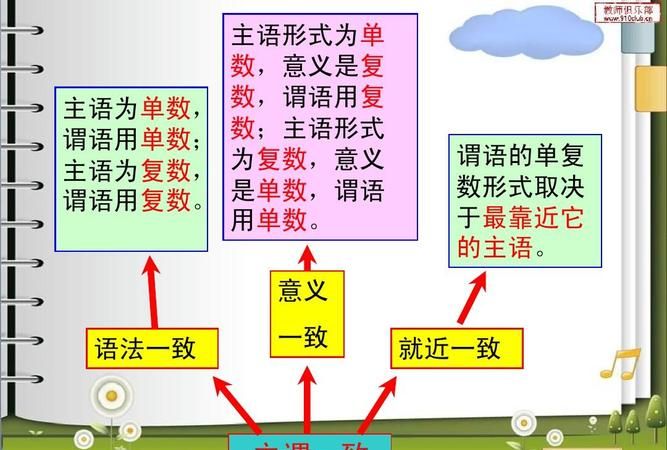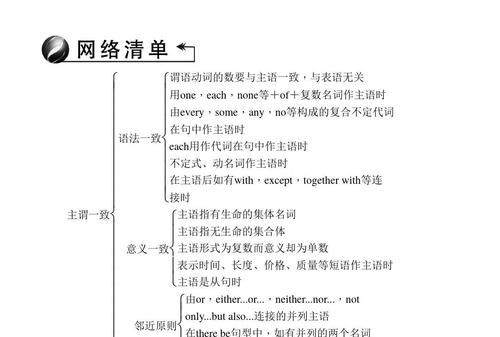本文目录
英语中主谓一致知识点总结
主谓一致是指:1)语法形式上要一致,即单复数形式与谓语要一致;2)意义上要一致,即主语意义上的单复数要与谓语的单复数形式一致;3)就近原则,即谓语动词的单复形式取决于最靠近它的词语。一般来说,不可数名词用动词单数,可数名词复数用动词复数,但当不可数名词前有表示数量的复数名词时,谓语动词用复数形式。 一、并列结构作主语时的主谓一致 并列结构作主语时谓语用复数,但是当主语由and连结时,如果它表示一个单一的概念,即指同一人或同一物时,谓语动词用单数, and 此时连接的两个词前只有一个冠词。同时,如果and连接的两个单数名词前若用each,every,no修饰,该名词短语作主语时,谓语动词也要用单数形式。 e.g. I) To mean to do something and to actually do something are two separate things.想干一件事和真干一件事是两回事。II) The food and the textile industry depend mainly on agriculture for raw material.粮食工业和纺织工业主要靠农业提供原料。III) The iron and steel industry is very important to our national economy.钢铁工业在国民经济中起重要作用。IV) No book and on pencils found in the schoolbag.书包里没有书和钢笔。 二、主谓一致中的就近原则 1.当there be句型的主语是一系列事物时,谓语应与最邻近的主语保持一致。e.g. I) There is a teacher and some students in the classroom.教室里有一名老师和一些学生。II) There are four books and a pencil box in his bag.在他的包里有四本书和一个铅笔盒。 2.当either… or… 与 neither… nor,连接两个主语时,谓语动词与最邻近的主语保持一致。 如果句子是由here, there引导,而主语又不止一个时,谓语通常也和最邻近的主语一致。 e.g. I) Either he or his children are to take part in the party.不是他就是他的孩子们来参加这个晚会。II) Neither my wife nor I am to persuade my daughter to change her mind.我和我爱人都没法说服我的女儿改变主意。III) Here is a pen, a few envelops and some paper for you.这儿有一支笔,几个信封和一些纸给你。 三、谓语动词与主语的一致 在主语是单数的情况下,如果主语后面跟有with,together with,like,except,but,no less than,as well as 等词引起的短语时,谓语动词与前面的主语一致,即谓语动词仍用单数。 e.g. I) An expert, together with some assistants, was sent to help in this work.一位专家和几位助手被派去协助这项工作。II) Justice, as well as the law, demands that these criminals be severely punished.法律和正义都要求严惩这些犯罪分子。III) No one except his two daughters is interested in the program.除了他的两个女儿之外没有人对这个节目感兴趣。 四、在下列情形下谓语需要用单数 1.代词each和由every,some,no,any等构成的复合代词作主语,或主语中含有each,every时,谓语需用单数。 e.g. I) Each of us has something to say. II) Any of these books is helpful in your English study.2.当主语是一本书或一条格言时,谓语动词常用单数。 e.g. Little Women is a book known to lovers of English. 3.表示金钱,时间,价格或度量衡的复合名词作主语时,通常把这些名词看作一个整体,谓语一般用单数(用复数也可,意思不变。)。 e.g. I) Two days was allowed for making the necessary preparations.II) Ten million dollars is not a small amount. 五、由指代意义决定的谓语单复数 1.代词what,which,who,none,some,more,most,all等词的单复数由其指代的词的单复数决定。e.g. I) Which is your book?Which are your books?II) None of the books are easy enough for us.None of this worries me. 2.集体名词作主语时,谓语的数要根据主语的意思来决定。如family, audience, crew, crowd, class, company, committee等词后用复数形式时,意为这个集体中的各个成员,用单数时表示该个集体。e.g. I) The committee meets twice a month. 委员会一月开两次会。The committee are divided in opinion. 委员们意见有分歧。II) The audience was enormous. 观众人很多。The audience were greatly moved at the words. 听了这话听众都很感动。 3.有些名词,如variety,number,population,proportion 等有时看作单数,有时看作复数。e.g. I) What is the population of Europe? 欧洲人口有多少?One third of the population here are workers. 这里三分之一的人口是工人。II) A number of students have passed the exam. 很多学生通过这次考试。The number of students in this college has increased a lot.这个学院的学生人数大大增加了。 六、与后接名词或代词的一致 1. 用half of, part of, most of, a portion of 等词引起主语时,动词通常与of后面的名词,代词保持一致。e.g. Most of his money is spent on his daily necessities.Most of the students have passed the exam.2.在一些短语,如 many a 或 more than one 所修饰的词作主语时,谓语动词多用单数形式。e.g. I) Many a person has ever seen this movie.II) More than one person has had that kind of experience.

高中英语语法主谓一致归纳总结
高中英语语法主谓一致三个典型用法举例
1. 形式上虽为单数,但意义为复数名词,如the police, people, cattle等作主语时,谓语动词用复数。如:

Cattle eat grass. 牛吃草。
注:people 作“民族”解时,其单数形式为people,复数形式为peoples,作主语时,应用语法一致原则。如:
The Chinese people is a great people. 中华民族是一个伟大的民族。
56 peoples make up the big family of China. 56个民族构成中国这个大家庭。
2. 主语是指一类人的“the+形容词(或过去分词)”时,谓语动词通常用复数,这类词有:the brave, the poor, the rich, the blind, the young, the old, the sick, the dead, the deaf and dumb, the oppressed, the injured, the wounded, the unemployed等。另外,像the Chinese, the British, the Irish等表示一个国家或民族的人的总称,作主语时,谓语动词也用复数。如:
The injured were taken to hospital. 受伤的人都送进了医院。
The English do not drink much wine. 英国人不喝很多酒。
3. 形式上为复数,而意义上却是单数的名词,如news, mathematics, physics,politics, economics及以s结尾的.书名、国名等作主语时,谓语动词用单数。如:
Mathematics is the language of science. 数学是科学语言。
His “Selected Poems” was first published in 1965. 他的诗歌选集最早是1965年出版的。
;英语主谓一致思维导图
因为在第1个句子中,crops是“作物”的意思,是一个不可数的名词,所以用has,而第2个句子,friends是“朋友”的意思,是一个可数名词,所以用have。
解析:
分数做主语时 ,谓语动词根据分数后的名词决定单复数,若是可数名词就用复数形式,若是不可数名词就用单数形式(即分数/百分数 +of +名词作主语,谓语动词要和of之后的名词保持一致)。
在第1个句子Two thirds of the crops has been damaged by the storm.(意思:在暴风雪中,地里的三分之二的作物都已被毁坏了)中,crops是“作物”的意思,是一个不可数的名词,所以谓语动词要用has。
在第2个句子中Two thirds of my frends have been abroad.(我三分之二的朋友都已经出国了)中,friends是“朋友”的意思,是一个可数名词,所以谓语动词要用have。

关于主谓一致:
主谓一致指谓语动词在人称和数上要和主语保持一致,即主语的人称和单复数形式决定着对应的谓语动词的单复数形式。
主谓一致包括语法一致、就近一致、意义一致和其他特殊情况:语法一致即谓语动词在单复数形式上要和主语保持一致;就近一致就是谓语动词要和靠近它的主语部分保持一致;意义一致就是谓语动词要和主语意义上的单复数保持一致。
主谓一致语法总结思维导图
主谓一致有三种一致原则,即:
一. 语法一致;
二. 概念一致(语言内容上一致);
三. 相邻一致(就近原则)。
具体讲解:
一. 语法一致;
1、单数主语、单个动词不定式、动名词短语以及句子做主语,谓语动词要用单数形式。复数主语,用and或both…and连接的动词不定式短语、动名词短语以及主语从句作主语,谓语动词则用复数形式。例如:
Serving the people is my great happiness.
为人民服务是我最大的幸福。
Whether we’ll go depends on the weather.
我们是否去要取决于天气的好坏。
2、当如下词或短语,如:
as well as/with/along with/like/ together with/ rather than/except but/including/
accompanied by/ plus/besides/in addition to/no less than 等引起的结构跟在主语后
面,不能看作是并列主语,该主语不受这些词组引导的插入语的影响,主语如是单数,其谓语动词仍然用单数形式。
The reading course book, plus its reference books, is helpful to college students.
教材加上参考书对大学学生是非常有益的。
The man together with his wife and children sits on the sofa watching TV.
那个人和他妻儿老小坐在沙发上看电视。
3、有些代词只能指单数可数名词,当它们在句子中做主语时,尽管在意义上是多数,谓语动词仍要用单数形式。这类代词有:
either, neither, each one, the other ,another,somebody ,someone, something,anyone, anything, anybody,everyone, everything, everybody,no one, nothing ,nobody; 例如:
Neither likes the friends of the other.
两人都不喜欢对方的朋友。
Everything around us is matter.
我们周围的所有东西都是物质。
4、当and连结的两个名词是指同一个人或同一件事,and后的名词前没有冠词,谓语动词应该用单数形式;在and后面的名词前有冠词,谓语就用复数形式。例如:
The bread and butter is served for breakfast. 早饭供应黄油面包。
The bread and the butter are on sale. 正在出售黄油和面包。
5、当one of, a portion of, a series of, a species of, a chain of 结构作主语时,谓语动词要用单数形式。例如:
One of those students has passed the examination.
这些学生只有一个考试及格了。
A series of pre-recorded tapes has been prepared for language laboratory use.
为语音课提前准备了一系列录音磁带。
6、由one and a half + 复数名词或the majority of + 名词做主语时,谓语动词视名词的单复数形式而定。例如:
The majority of the damage is easy to repair.
大部分的损坏品都容易修理。
One and a half students are reading English.
大部分学生在读英语。
7、plenty of, half of, a lot of, lots of, heaps of, loads of, scads of等 + 可数与不可数名词做主语时,不可数名词的谓语只用单数,可数名词的谓语视可数名词的单复数而定。例如:
There is plenty of water in the pail.
桶里还有好多水。
There are plenty of eggs in the box.
箱子里有好多鸡蛋。
8、由more than one (或more than one + 单数名词),many a + 单数名词做主语,谓语动词要用单数形式。例如:
More than one student has passed the examination.
不止一个学生通过了这次考试。
Many a boy learns to swim before he can read.
许多孩子在认字前就学会了游泳。
9、如果名词词组中心词是“分数或百分数 + of + 名词”,谓语动词的单、复数形式取决于of后的名词或代词的单、复数形式。例如:
Over three-quarters of the land has been reclaimed.
四分之三多的土地已经收回了。
Two-thirds of the people present are against the plan.
到场的三分之二的人都反对这个计划。
10、定语从句谓语动词的单复数形式应与先行词一致。例如:
He is one of the men who were chosen to represent the group.
被选出来代表该组的人他是其中之一。
“Keep cool” is the first of the rules that are to be remembered in an accident.
“镇静”是事故发生时应当牢记的第一条原则。
二. 概念一致原则:
1、有些集合名词如crowd, family, team, group, government, committee, class, school, union, firm, staff, public等,它们做主语时,谓语动词的数要根据语言内容而定。如果它们作为一个集体单位时,动词用单数形式,如就其中的各个成员来说,则谓语用复数形式。例如:
His family is going to move.
他准备搬家。
His family are very well.
他家人身体都好。
2、有些表示总体意义的名词,形式上是单数,而意义上却是复数,谓语动词要用复数形式,如people, police, militia, cattle, poultry等。例如:
The police are searching for a tall dark man with a beard.
警察正在搜寻一位肤色黝黑、长胡子的高个子男人。
3、有些名词形式上是复数,而意义上却是单数。如news, means, works.还有许多以-ics结尾的学科名称,如economics, physics, mechanics, politics等,它们做主语时,谓语动词要用单数形式。例如:
Politics is a complicated business.
政治学是一门复杂的东西。
Here is the news.
4、用and连接的单数主语,前面有each, every, many a, no等修饰时,谓语动词要用单数形式。复数主语与each连用时,应不受each的影响,谓语动词仍用复数形式。例如:
Every boy and girl is treated in the same way.
每个男孩、女孩都是以同样的方式对待的。
Many a boy and many a girl has seen it.
很多姑娘小伙子都见过。
The old workers and the young each have their own tools.
青老年工人都各自有自己的工具。
5、表示重量、度量、衡量、价值的复数名词做主语,谓语动词常用单数形式。例如:
Twenty miles is a long way to walk.
二十里地可是个不近的路程。
Three pints isn’t enough to get me drunk.
三品脱还不至于把我灌醉。
6、the +形容词作主语时,如主语指的是一类人,谓语动词用复数形式;如果指的是单个人或抽象概念,谓语动词用单数形式。例如:
The departed was a good friend of his.
离开者是他的一位好友。
The old are playing Beijing Opera there.
老人们正在那表演京剧。
三. 就近原则:
相邻一致是指谓语动词的人称和数常常与最近作主语的词语保持一致.常出现在这类句子中的连词有:or, either… or …,neither… nor …,not only… but also …等.例如:
Either I or they are responsible for the result of the matter.
不是我,就是他们要对那件事的结局负责任.
Neither the unkind words nor the unfriendly attitude has caused me any distress.既不是那些不友好的话,也不是那不友好的态度让我沮丧.
Not only he but also all his family are keen on concerts.
不仅仅是他,而且是他全家人都很热衷于音乐会.
Neither his family nor he knows anything about it.
他全家人和他都不知道那件事.
注意:谓语动词用复数:
1、复数主语,用and或both…and连接
2、形式上是单数,实际表示复数意思
谓语动词用单数
1. 单数主语、单个动词不定式、动名词短语以及句子做主语
2. 形式上是复数,实际上是单数neither, everything
3. one of, a portion of, a series of, a species of, a chain of 结构作主语

以上就是关于英语主谓一致思维导图,英语中主谓一致知识点总结的全部内容,以及英语主谓一致思维导图 的相关内容,希望能够帮到您。
